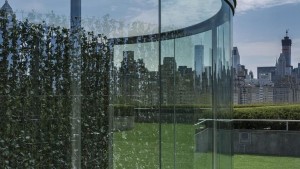by Ariella Budick, Financial Times, May 5, 2014

‘Hedge Two-Way Mirror Walkabout’ sits on the roof of the Metropolitan Museum in New York
Photo: Hyle Skopitz
Source: www.ft.com
A seriously charming and richly allusive installation has appeared on the roof of the Met
The Metropolitan Museum’s remote rooftop garden has always offered savvy visitors respite from hall after hall of sublime majesty. Right now, it opens on to an artificial-grass oasis that hovers like a magic carpet above the edge of Central Park. Lawn chairs are temptingly scattered about. The view beckons. And off to one side, a mirrored pavilion perches on its glowing patch of green, catching the kaleidoscopic tumult of the city and playfully casting it back.
Dan Graham collaborated with landscape architect Günther Vogt to transform the Met’s severe space into “Hedge Two-Way Mirror Walkabout”, a seriously charming funhouse. It’s a mind-bending piece of walk-in sculpture, a two-chambered bubble of mirrored glass and steel that invites viewers to glimpse themselves in its reflective surfaces. However we look at it, we see ourselves askew – here, sleekly thin; there, grotesquely fat, mixed up with the people on the other side of the transparent wall and a flickering melange of sky, leaves, buildings and passing clouds.
Graham’s rooftop pavilion teems with allusions. It invokes, first of all, the extravagantly ornamental structures – faux Greek temples, mock gothic ruins – designed as picturesque points of interest in 18th-century English gardens. At Stowe, Lord Cobham hid a “Temple of Ancient Virtue” among the vegetation, honouring the greatest Greeks and expressing his yearning for Hellenic antiquity. Graham has fallen under a more modern version of the neoclassical spell: he finds inspiration in the stripped-down austerity of Mies van der Rohe’s Barcelona Pavilion, which he admires both because it was always meant to be temporary, and because it effectively blends vegetation and reflective glass.